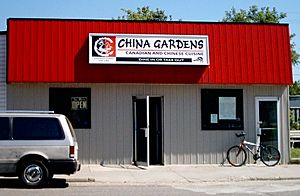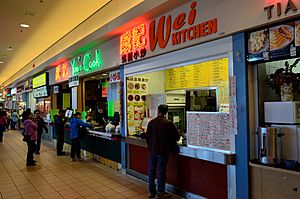Canadian Chinese cuisine facts for kids
Canadian Chinese cuisine (French: Cuisine chinoise canadienne) is a special kind of Canadian food. You can find it in many take-out and dine-in restaurants all over Canada. It was the first type of Chinese food widely sold in Canada.
This cooking style was created by early Cantonese immigrants. They changed traditional Chinese recipes to fit Western tastes. They also used ingredients that were easy to find in Canada. This food style grew in a way similar to American Chinese cuisine.
Contents
The Story of Canadian Chinese Food
In the 1800s, Chinese workers helped build the Canadian Pacific Railway. This railway connected Montreal, Québec with Vancouver, British Columbia. Many workers stayed in Canada after the railway was finished.
They often opened small, affordable restaurants. Some worked as cooks in mining camps or private homes. They made different versions of traditional Cantonese food. Local people really liked these dishes.
In many small towns in Western Canada, a Chinese "café" was often the first restaurant. Sometimes, it was the only one. People enjoyed trying Chinese food because it was new and different. Chinese communities became very good at running restaurants. This helped them create a new home in Canada.
In British Columbia, a type of buffet called the "Chinese smörgåsbord" began. This happened in Gastown (which became Vancouver). Loggers and millworkers asked their Chinese cooks to put food on a steam table. This made it easier to serve many dishes at once.
Later, with cars and drive-in restaurants, Chinese take-out became even more popular. There were even Chinese drive-ins, like the "Dragon Inn" chain.
Bill Wong, a restaurant owner in Montreal, opened the city's first Chinese buffet. It was called "House of Wong" in the 1950s. He later opened another famous restaurant, "Bill Wong's," in 1962.
New Waves of Chinese Immigration (1960s–Today)

More Cantonese people started moving to Canada in the 1960s. This increased a lot in the 1980s. Many families from Hong Kong moved to Canada. They were preparing for China's administrative take-over of Hong Kong.
Canada was a popular choice for immigrants. It had good immigration policies and a high standard of living. There was also an existing Chinese community.
Today, Chinese Canadian citizens are the largest visible minority group in Canada. Chinatowns are in most major Canadian cities. The biggest ones are in Toronto, Vancouver, Montreal, and Calgary.
This new wave of immigration brought a desire for more traditional Chinese food. Newer Chinese restaurants often serve authentic Chinese dishes. These places cater to immigrants. You can find everything from Cantonese dim sum to Hakka cuisine with a South Asian touch.
Where to Find Canadian Chinese Restaurants
Even very small towns in Canada usually have at least one Canadian Chinese restaurant. Many towns that don't have big chain restaurants still have a successful Chinese food place. However, in larger cities, some older independent restaurants are facing challenges. Delivery services and buffets are becoming more popular.
In many towns across the prairie provinces and northern British Columbia, you can find a Chinese café. These often serve "Canadian and Chinese cuisine." For example, in Glendon, Alberta, there's the Perogy Café. It serves "Ukrainian and Chinese Perogies," which means pot stickers. This restaurant is actually owned by a Vietnamese family.
Canadian Chinese restaurants are very popular. Even some older, more traditional Chinese restaurants might offer Canadian Chinese dishes. This helps them serve non-Chinese customers too.
Newer Chinatowns, especially in Vancouver and Toronto, offer many different types of Chinese food. They cater to recent Asian immigrants. You can find Szechuan, Hakka, Chiuchow, Taiwanese, and even Buddhist cuisine restaurants. One of the largest groups of Chinese restaurants in North America is in the Golden Village area in Richmond, BC. This area is near Vancouver, BC.
Toronto's Old Chinatown has seen some famous restaurants close since the late 1990s. In newer suburban areas like Richmond Hill and Markham, you'll find many Chinese restaurants. These range from small eateries in strip malls and food courts to large, fancy places.
These larger restaurants often host special events like weddings. They might offer discounted dim sum lunches on weekdays. This helps them attract more customers. Many older fancy restaurants have traditional Chinese decor. This includes red and yellow colors and images of the Fenghuang (Chinese dragon and phoenix). Newer places often have a more modern, Western style.
Most Canadian Chinese restaurants are independent businesses. However, there are some chains. Examples include "Hons Wonton House" in Vancouver and "Congee Wong" in Toronto. Another well-known chain is "Mandarin Restaurant" in southern Ontario.
Unique Canadian Chinese Dishes
Researchers like Josephine Smart have studied how Canadian Chinese food has changed. They look at how Chinese food became "Canadianized" and how it kept its "authentic" roots.
Chinese restaurants often use different ways to write Chinese names in English. These are usually based on Cantonese sounds.
For take-out, Canadian Chinese restaurants often use Foam take-out containers. Some use special plastic containers. In the past, aluminum pie dishes were common.
While Canadian Chinese food is similar to American Chinese food, Canada has some unique dishes:
- Ginger beef: This dish has deep-fried strips of beef. They are covered in a sweet, dark sauce with ginger, garlic, and hot peppers. It's often served with thin strips of carrots and onions. Ginger beef is very popular in Calgary and across the Canadian Prairies. Many believe it was invented by George Wong at the Silver Inn in Calgary in the mid-1970s.
- Newfoundland chow mein: This version uses thinly sliced cabbage instead of egg noodles. This is because it was hard to get real Chinese ingredients in Atlantic Canada long ago.
- Montreal peanut-butter dumplings: These are wonton or jiaozi dumplings. They are covered in a sauce made with peanut butter, honey, and soy sauce. This dish likely started in the 1980s at a restaurant called "le Piment Rouge." It quickly became popular in Montreal.
- Thunder Bay bon bons: This is a salty, deep-fried rib dish. It's said to go well with beer. Lam Pang, a Chinese restaurant owner in Thunder Bay, invented it in the 1940s. The ribs are marinated overnight, dipped in egg, and coated before frying.
- Fried macaroni: This dish is stir-fried macaroni with soy sauce, meat, and vegetables. It is served in Québec.
- Green onion cake: This is a flat, breaded cake made with scallions. It's a popular dish in Edmonton. Siu To, a restaurant owner, brought this Northern Chinese treat to the city.
For more special occasions, Chinese Canadians might look for more traditional Chinese food. A Chinese wedding reception usually has nine or ten courses. Expensive dishes like shark fin, abalone, lobster, jumbo shrimp, squab, sea bass, or sea cucumber are common. A whole cooked fish, chicken, or pig means good luck and completeness in Chinese wedding culture.






